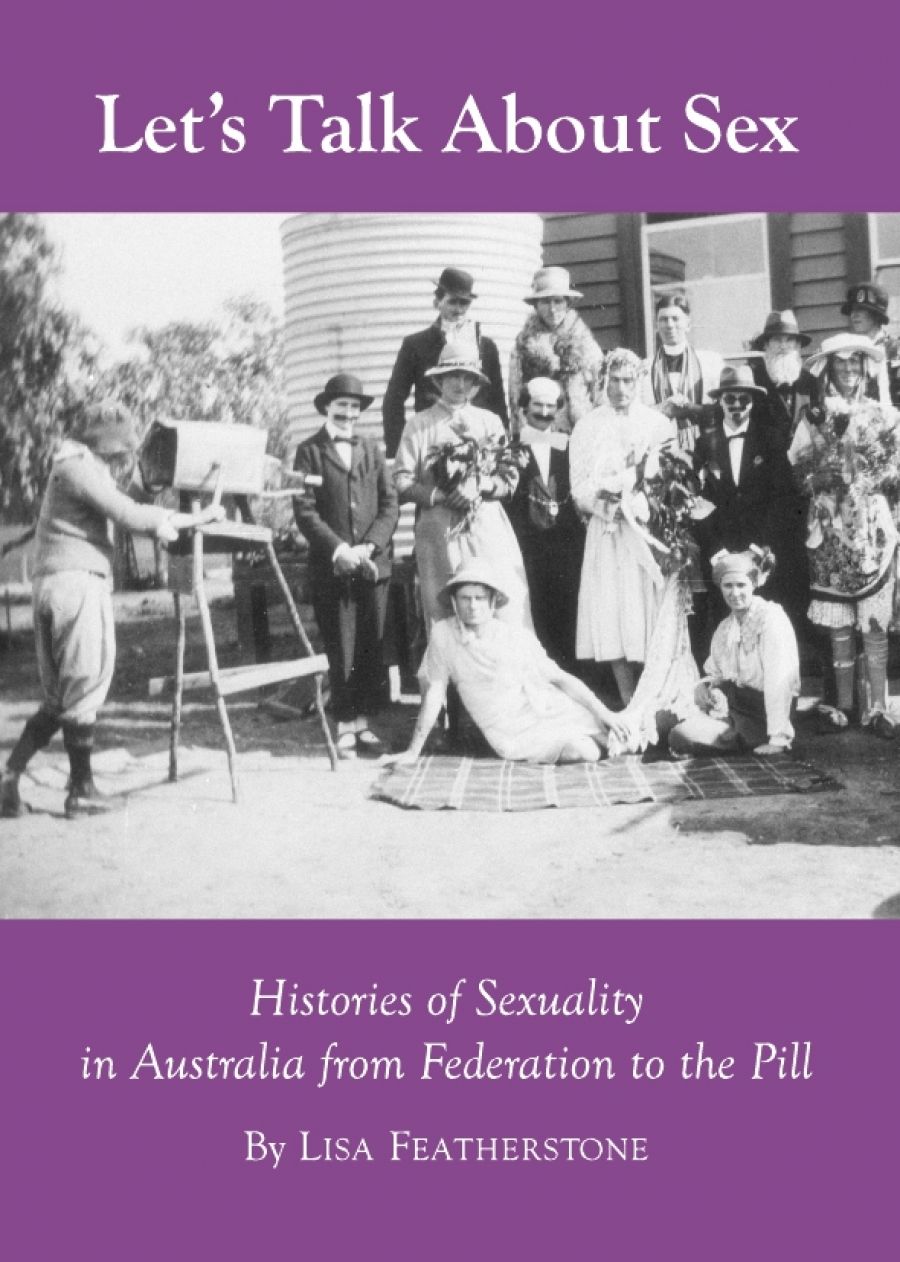
- Free Article: No
- Contents Category: Gender
- Review Article: Yes
- Online Only: No
- Custom Highlight Text:
In Australia’s past, sex has been theorised, pathologised, even criminalised, but comparatively little has been written about the topic. One of the more exciting developments in Australian historiography over the past fifteen years has been the inclusion of gay and lesbian narratives. These perspectives have broadened understandings of Australia’s past and have shown how reading original historical sources against the grain can provide evidence about the intimate lives of Australians.
- Book 1 Title: Let’s Talk about Sex
- Book 1 Subtitle: Histories of Sexuality in Australia from Federation to the Pill
- Book 1 Biblio: Cambridge Scholars Publishing, £44.99 hb, 338 pp
Lisa Featherstone’s Let’s Talk about Sex builds on past histories of gay and lesbian sexualities and considers the history of sexuality more broadly in Australia from 1901 to the advent of the contraceptive pill. Featherstone argues that there was a fierce questioning about sexual normativity in these years and that sexual identities and sexual possibilities challenged a controlling regulatory system. She captures the anxieties that have surrounded sexual expression, particularly homosexuality. Let’s Talk about Sex, Featherstone’s first book, is an impressive début indeed. As an academic at the University of Newcastle, she has been a strong advocate of sexuality studies. With a research background that covers topics such as masculinity, childbirth, race and medicine, and child health, Featherstone is ideally positioned to undertake this history.
The narrative adopted in Let’s Talk about Sex is broadly chronological, with ten chapters providing a history of Australian sexual behaviour and regulation over sixty years. In 1903 the New South Wales government displayed an overly invasive concern with women’s bodies and reproduction when it held the world’s first Royal Commission into a declining birth rate. Since then, debates over birth control, abortion, and sex education have been deeply intertwined with heterosexual sexuality. Venereal disease has a long history in Australia. With the return of soldiers after World War I, infection rates increased and official fears were exacerbated. World War II intensified a range of moral panics, including alarm over prostitution and sex crimes. In 1961, Australian women proved to be early adopters when they began using the contraceptive pill in large numbers.
Male and female sexualities were constructed and governed differently throughout the era considered here. Featherstone argues that female sexuality at the start of the twentieth century was subsumed into maternity. This is not to suggest that all women lived erotically unfulfilled lives. Indeed, Featherstone finds traces of potent heterosexual and same-sex desire. Nevertheless, she finds that this desire was frequently characterised as excessive or pathologised as nymphomania. Lesbianism was marginalised.
Featherstone asserts that men were allowed greater privilege and licence with regard to sexuality, but were also subjected to societal constraints. Male sexuality was conceptualised as hydraulic, active, and persuasive, yet there were continued calls for male sexuality to be tamed and regulated. Masturbation was universally condemned by the medical profession, and prostitution was heavily discouraged. Perhaps the view of male sexuality as active, along with the privileged position of men in the early twentieth century, was responsible for the low rate of prosecutions for sexual crimes against women. Male-to-male sex was both marginalised and pathologised in this era, with the medical profession and the legal profession both playing a regulatory role.
Although Michel Foucault’s theories on the regulation of bodies dominate this text, Featherstone notes that the most substantial challenges towards this regulation have come from non-heterosexual sexualities. Men and women engaging in same-sex desire have significantly influenced shifting attitudes towards sex and sexuality. Featherstone acknowledges that Australian sex was not always hetero, marital, reproductive, and easily contained.
Historians of sexuality would be well aware of the difficulties in finding sources that illuminate the complexities of desire, sexual transgressions, and the power of regulatory systems. The major strength of Let’s Talk about Sex is the heavy body of evidence that Featherstone has incorporated into her narrative. A range of newly unearthed personal papers, official publications, rare periodicals and books support the book’s argument but also add interest and colour to the narrative. We meet William James Chidley, who walked the streets of Sydney in a toga in 1911, carrying his self-published sex guide, The Answer. Then there is the unlucky Sydney Thomas Smith, who, during the course of World War II, walked the streets of Brisbane dressed as a woman, convinced two American sailors to pay him ten dollars for sex, got into a fight when his sex was exposed and was subsequently sentenced to six months’ imprisonment.
In terms of omissions, a more involved discussion of methodology would have been useful, but the concise introduction will probably serve to make this text more accessible to a broader audience. Extending the text further into the 1970s would have allowed further scope to chart the impact of the contraceptive pill and the so-called sexual revolution. It does appear, however, that Featherstone is extending her research further, and I would anticipate that a future text may adopt the late 1960s as a starting point.
Let’s Talk about Sex, lively and engaging, is a well-written and welcome addition to an emerging field. This book will meet the needs of students of Australian history but will also be of interest to those wishing to understand the ways in which sex and sexuality influenced the lives of Australians between 1901 and 1961.


Comments powered by CComment